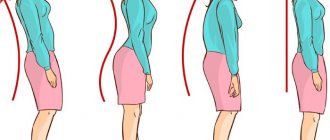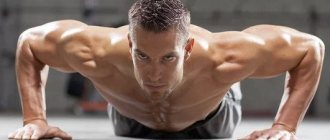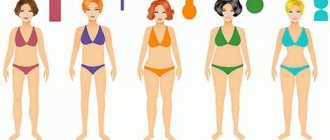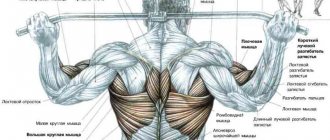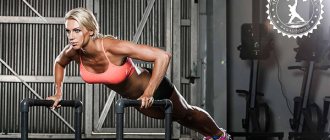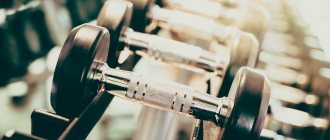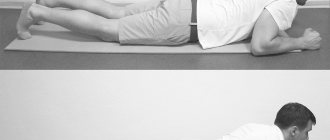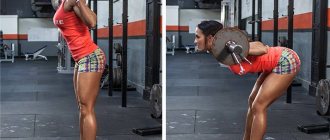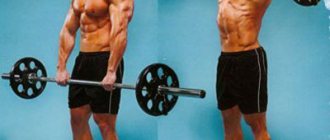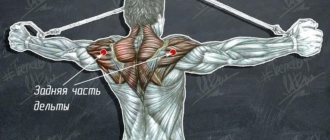All fans of bodybuilding and fitness dream of a harmonious, proportional figure, but not everyone can achieve this shape. Exercises for the shoulders and back are designed to give your figure the coveted tapered torso.
Development of shoulder and back muscles
You've probably trained them before, but without much enthusiasm. Either you didn't see that these muscles needed special attention, or you were carried away by other priorities: arms or chest, for example.
Everything must be different now. Let's say you work out in the gym three times a week: on Mondays, Wednesdays and Fridays. Then you should devote Monday to your shoulders, Wednesday to your back, and Friday to everything else. And you will need to adhere to such tactics for at least two months. It is clear that the amount of load on other parts of the body will have to be reduced.
Otherwise there will be no sense, because the body’s energy resources are not unlimited. Therefore, you will not be able to “give in steam” in relation to the shoulders and back, while maintaining the number of approaches and exercises performed for other muscle groups. But your ultimate goal is a beautiful and harmoniously developed body, isn’t it?
And if your arms or thighs are already too big, why try to make them bigger? A supporting program is quite enough.
Training programs for shoulders and back
So, shoulders
As you know, shoulders are worked by three types of movements:
- presses
- swings
- pulls to the chin.
Obviously, it is important to include exercises from all three groups in the shoulder specialization in order to load them from all possible angles and achieve maximum development. (See also: Shoulder Exercises section).
Dumbbell swings from side to side
Side swings focus on the lateral bundles of the deltoid muscles, that is, the shoulders, and this is exactly what you need most. In addition, the swings performed first will perfectly warm up the muscles. Personally, I prefer seated swings, since in this case it is not possible to use the force of inertia and reduce the load on the shoulders.
Technique for performing side dumbbell swings:
- In the starting position, you hold dumbbells on the sides of your thighs with your palms facing inward.
- As you inhale, lift the dumbbells from the sides, turning your hands as you move so that your little fingers are at the top. It's like pouring water out of a glass.
- Raise the dumbbells to approximately eye level.
- Do not jerk or throw weights sharply down; work evenly and smoothly. In general, I recommend 3-4 sets of 8-10 reps. Rest between sets: a minute to a minute and a half.
Seated dumbbell press
This exercise perfectly increases volume in the shoulder area, allows you to work each side of the body independently, develops muscle coordination and makes it possible to work in a greater amplitude than when using a barbell.
Seated dumbbell press technique:
- In the starting position, you take dumbbells and sit on a bench with the back slightly inclined (10 degrees less than a right angle). At the moment of start, the palms “look” forward.
- Place the dumbbells in the area of the collarbones and with a powerful movement squeeze them up onto straight arms.
- Then return to the starting position.
After 1-2 warm-up sets, I recommend doing 2-3 working sets. The number of repetitions in the approaches remains the same 8-10. Rest between sets is a little longer: 2-2.5 minutes.
Bent-over dumbbell swings
This exercise works great on the dorsal or posterior deltoid muscles. Well, you say, why do I need back buns when I want to become wider? The fact is that in a developed state, the rear delts make the torso visually wider, especially when viewed from behind. So it is necessary to train these areas. Bent over swings can be done while sitting or standing.
Seated dumbbell press technique:
- In the starting position, bend over so that your chest rests on your knees. Dumbbells - on the sides of the hips, palms “looking” inward.
- Then you do the same as in the side swings while sitting.
- Raise the dumbbells until they reach a line parallel to the floor.
In sitting swings and in sitting bent over swings, your arms should be kept slightly bent at the elbows. This will prevent you from injuring your biceps. Here you perform 3-4 sets of 8-10 repetitions. Pauses between approaches are a minute and a half.
Barbell rows to the chin (broach)
Some athletes completely ignore this exercise, considering it useless. Others almost pray to it, believing that there is simply no better exercise for the trapezius muscles and shoulders. (See the article “How to pump up your trapezius muscles”).
Regardless, I think chin-up rows should be included in your training plan. If only because it puts a completely different kind of stress on the shoulder muscles. The exercise should be performed with a medium grip, this is when the hands are located on the barbell at approximately shoulder width.
Broaching technique:
- In the starting position, you hold the barbell in front of you with a similar grip.
- Then you begin to pull it towards the chin area, while your shoulder joints move back.
- At the top point, you can take a short pause, after which you return to the starting position.
In total, here you do 4 sets of 8-10 repetitions. Pauses between approaches are one and a half to two minutes.
What sports nutrition will make your body grow?
Impact training for the shoulders and arms is one of the components of success. The second is high-quality nutrition of growing muscles. And also their stimulation: before training, it won’t hurt to take a pre-workout and a pump. Then the training will be tougher, and it will be much easier to give it your all. But immediately after training your arms and shoulders, don’t forget to take a protein shake or gainer (if your goal is weight gain). Plus, a standard dose of BCAA (about 10 grams) would be a good addition to it. You can “forget” to take protein or gainer on rest days, but after each workout, taking it is simply necessary.
For those who are just deciding whether they need sports nutrition, we recorded a video below:
https://youtu.be/96YfzoIZclo
We recommend: buy sports nutrition that works!
Now let's talk about back training
Here you should place the main emphasis on exercises that develop the width of the back, namely: pull-ups on the bar, pull-downs from above to the chest with a wide or narrow grip and pullovers.
True, I would still advise leaving at least one exercise for developing the overall “mass” of the back muscles. Agree, a wide, but at the same time flat back with protruding shoulder blades will make you look more like a flounder than a shining, chiseled figure. Therefore, I propose the following program of action.
Pull-ups
- You grab the bar with a wide grip, rest your gaze on it and smoothly pull your torso not strictly upward, but as if tangentially, so that at the top point of the movement you touch the bar with your chest, not your chin.
- By the way, you should bend in the chest area. This is how the latissimus muscles contract as much as possible.
You can forget about the classic “soldier’s” pull-ups, since they develop your arms rather than your back. From the top point you smoothly go down. In total, you should perform 4 sets of 8-10 repetitions. If you reach the 10 mark on all four sets, add extra weight to your belt. Rest between sets - one and a half to two minutes.
Wide grip lat rows
We will try to “finish off” the outer areas of the latissimus muscles with this exercise.
Technique for performing vertical block pulls:
- In the starting position, your hands hold the handle of the block above your head with a wide grip.
- From this position, smoothly pull the pulley handle down until it touches your chest.
- The chest should be kept arched forward.
- Touching your chest, also smoothly return to the starting position.
In total, you have to do 4 sets of 8-10 repetitions here. Rest between sets - a minute and a half.
Many people underestimate such an exercise as pullover , and if they do it, it is only with the goal of expanding the chest. Meanwhile, this is an excellent exercise for back width. Developed serratus muscles, which are loaded with pullovers, make your lats visually noticeably wider.
Bent-over barbell row
It works the entire back and will not allow it to become thin while you are struggling for maximum width.
Technique for performing bent-over barbell rows:
- In the starting position, you stand slightly leaning forward. The barbell is held in the arms extended downwards. The palms “look” back.
- From this position, you pull the projectile to the groin area. The hands act as “hooks” and nothing more. All attention is on moving the shoulder blades back.
- At the top point of the movement, you can pause for a second or two, no more. This will make the exercise more effective.
Perform a total of 4 sets of 8-10 repetitions.
It would seem that the above exercises for the shoulders and back are no different from miracles, but in a couple of months you won’t recognize yourself. Your figure will acquire a cherished sporty contour, which you can safely put on public display. The company guarantees!
Insufficient number of repetitions in the set
Unlike most other muscle groups, shoulders love high-repetition sets.
If you are successfully following all the previous recommendations, but you still have the question “why your shoulders don’t grow,” there is one more important detail. Not doing enough reps per set can also cause your shoulders to be underloaded and not grow. Here it must be said that, unlike most other muscle groups, shoulders love high-repetition sets. So if you're limiting yourself to 6-9 reps, that might be good for the chest, but it's definitely not good enough for the shoulders. Increase the number of repetitions to 12-15 , and the effectiveness of your training will increase by an order of magnitude.
By the way, to increase the number of repetitions, you can use the drop set method and lose some of the weight at the moment of failure. Just remember - it’s better not to abuse this technique and use drop sets no more than once a month.
Now you know why your shoulders don’t grow and how to avoid mistakes and stagnation in training. Follow our five tips, and you will definitely see progress, and your deltoids are guaranteed to grow. But remember: one of the main tips when training deltoids is not to get hung up on one technique , alternate loads and include new exercises for 2-3 months.
This is the only way your muscles will not get used to the existing loads and will be able to grow confidently.
Some tips
Throw aside the baby dumbbells. Nothing will develop your traps like heavy barbell shrugs. Take a barbell, load it to the maximum and don’t be afraid to use cheating - this is the only way your traps will look like mountain peaks.
And don't rotate your shoulder joint, just lift the barbell up and down.
Seated dumbbell press
This exercise is familiar to everyone who has ever been to the gym. However, not many people follow the correct technique for performing it.
First of all, you should pay attention to the position of your hands: your elbows should look strictly to the sides, and your palms should face forward. The press occurs upward and inward, while the arms and torso are in the same plane
At the top point, the dumbbells should be brought together, but not pushed together. The reverse movement should be slow and controlled until your shoulders are parallel to the floor.
Pull-ups
Pull-ups are the best exercise for the upper body, but they are also quite challenging for beginners. If you haven't learned how to do pull-ups yet. you can replace it with a pull rod of the upper block. And if you can do more than 10-12 pull-ups per set, then it’s time to start using weights.
Seated block row
Many people underestimate this exercise, but it is this exercise that, as a counterweight to the bench press, will help you create a harmonious physique. Ideally, you should be able to lift the same amount of weight as you bench press, so don't be shy about pushing yourself harder.
If for some reason you don’t like the lat pulldown or you simply don’t have access to the right machine, you can replace it with a bent-over barbell row.
